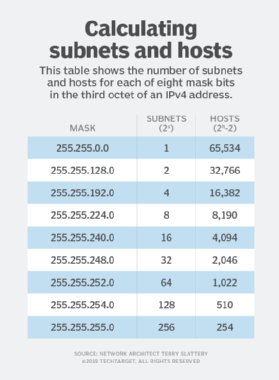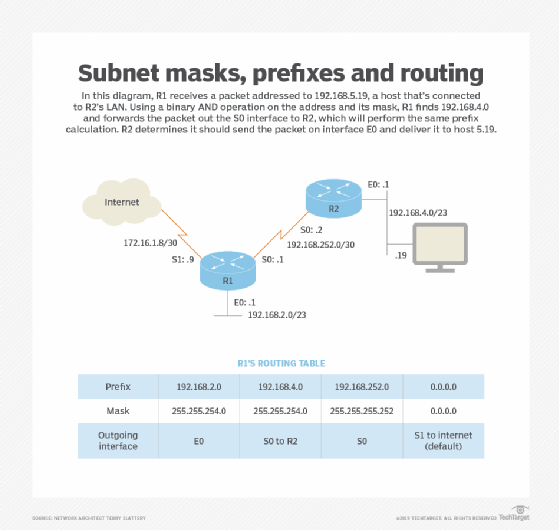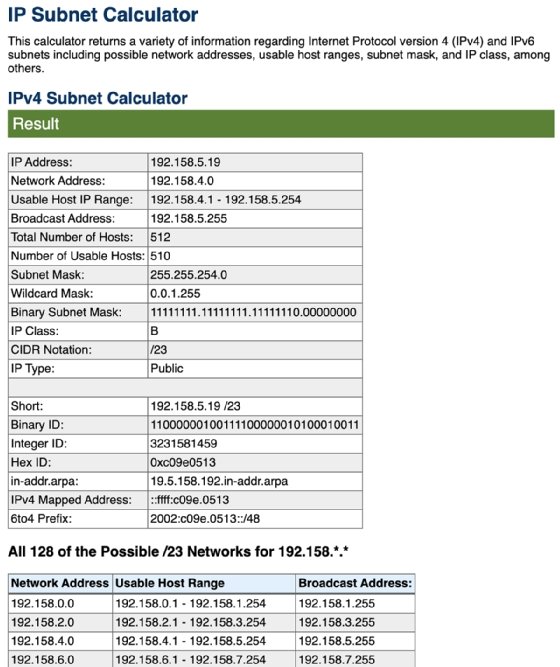How To Find Host Address From Subnet Mask
In this article, we explore IP addressing and subnetting and show how to utilise this valuable information to real-world scenarios. Nosotros address how to summate a subnet mask past using host and subnet formulas. Before nosotros move on, though, we should respond two key questions.
What is subnetting?
ISPs allocate IP address ranges to organizations based on the potential number of networks and hosts, or endpoints, that organizations crave. Today, the allocations follow the Classless Inter-Domain Routing (CIDR) assignment method. The system and so subdivides the allocated accost space into smaller allocations for each subnetwork within the organization, using a process chosen subnetting. The outcome of subnetting is the number of subnetworks increases, while the number of usable host IP addresses decreases. Each subnetwork is known every bit an IP subnet.
Why use subnetting?
Subnetting enables assigned network addresses to exist broken into smaller, efficient allocations that are more than suitable for each network within the organisation. For example, a point-to-signal WAN link between ii routers simply needs two addresses, while a LAN segment may need to support many hosts, such as servers, workstations, laptops and Wi-Fi-connected mobile devices.
Subnetting and route summarization piece of work together to make routers more than efficient by reducing the size of routing tables. Routers far away from a destination don't need much addressing item, then routes tin be summarized to a large degree. Only, as packets become closer to the destination network, routers will need more local routing information, such as the local subnet mask. By applying the mask to a packet'due south destination address, routers can determine which specific network segment contains the destination host and properly evangelize the bundle.
Next, permit'southward review some background data, including what network administrators demand to know about IP addressing and subnetting. We recommend starting with a review of some basic elements of IP addressing and subnetting:
- IP addresses must exist unique on the internet when using public IP addresses and on a private network when using private IP addresses.
- IPv4 addresses are 32 bits made up of four octets of viii bits each. To summate the subnet mask, convert an IP address to binary, perform the calculation and then convert back to the IPv4 decimal number representation known equally a dotted quad. The same subnetting procedure works for IPv6 addresses.
- A subnet mask tells the computer what function of the IP accost is the network portion of the address and what part identifies the host address range, which are addresses that are assigned to host computers on that network. A longer subnet mask -- meaning more 1 $.25 in the mask -- creates more IP subnets that have a smaller host address block size.
- Subnetting breaks a big network into smaller networks by extending the length of the subnet mask. This increases the number of subnetworks, while reducing the number of hosts per subnet. Organizations will typically utilise several unlike subnet masks for different sizes of networks. For example, a point-to-point link with only ii devices would use a 31-scrap mask. An office LAN or data heart LAN, nevertheless, would use a shorter subnet mask that allows more hosts. Determining the tradeoff betwixt the number and size of subnets is explained below.
- Today, classless IP addresses with variable-length subnet masks are used almost exclusively, and classful IP addresses -- known as either Class A network, Class B network or Class C network -- are used merely for certification testing or older routing protocols. A Class D network is used for multicast, and there is an experimental allocation known as Class E.
- A default gateway is a device, typically a router, where hosts ship packets that are destined for a device not on the local LAN. Over again, the device knows what is and what is non on the local LAN past using its assigned subnet mask to compare its local IP accost and subnet with the destination's IP address and subnet.
- Private IP addresses, also known as Request for Comment 1918 addresses, are used by most networks today. These special IP addresses are not routable over the internet and must be translated to public IP addresses when those devices demand to talk to the internet, either through a proxy server or through Port Address Translation.
Now, let's learn more than about IP addressing and subnetting and how they apply to your existent-globe network.
Using the host'due south formula
A common, real-world question when laying out your network is: "What subnet mask do I need for my network?" To respond this question, let'southward learn how to use the host's formula.
The host's formula will tell you how many hosts volition be allowed on a network that has a sure subnet mask. The host's formula is 2h - 2. The h represents the number of 0s in the subnet mask, if the subnet mask were converted to binary. The first and concluding addresses are reserved: the first to place the network and the last to exist used as the broadcast address.
Pace 1. Observe host range
To use the host'southward formula, let'southward kickoff look at a elementary instance. Say you program to use the IP address space 192.168.0.0. Currently, you take a small-scale network subnet with twenty hosts. This network will grow to 300 hosts within the adjacent twelvemonth, however, and you plan to accept multiple locations of a similar size in the future and demand to enable them to communicate using this accost space.
With a single network subnet and only 20 hosts, the simplest affair to do would be to use 255.255.255.0 equally your subnet mask. This would mean you would have 192.168.0.1 through 192.168.0.254 for your hosts. The address 192.168.0.0 is reserved as the network subnet identifier, and 192.168.0.255 is reserved for the network broadcast accost.
Stride 2. Catechumen to binary
Before yous decide to apply this subnet mask, however, allow's apply the host's formula to it. To apply the host'due south formula in this scenario, you take the subnet mask 255.255.255.0 and catechumen it to binary. This would give you: 111111111 11111111 11111111 00000000.
As you can see, in that location are eight 0s in the subnet mask. To use this with the host'south formula, you would calculate 28 - 2. This comes to 256 minus the two reserved addresses, or 254. So, with the subnet mask specified, you will go 254 usable hosts. This would conform your 20-user network now but won't support your future network expansion to 300 hosts.
Step three. Calculate the full number of hosts per subnet
Y'all should programme alee and choose the best subnet mask the showtime time. This prevents yous from having to go back later and change all the IP addresses on this network. Calculation 1s to the subnet mask means you get fewer hosts per network subnet only more than network subnets. If you remove 1s from the subnet mask, you go more hosts per network but fewer networks. The latter is what we need to do.
To do this, let's take abroad one of the 1s to make our subnet mask:
11111111 11111111 11111110 0000000
In decimal number, or dotted quad representation, this is 255.255.254.0.
This means you take 9 0s in the host portion of the subnet mask. To apply the host's formula with this subnet mask, nosotros'd calculate 29 - 2. The number of usable host IP addresses is 512 minus two, or 510. This would definitely suit a 20-user network at present and future network and host expectations of 300 hosts.
Considering that information, nosotros know the virtually efficient subnet mask for the network is 255.255.254.0. The valid host address range for each subnet must be written equally two ranges, due to the limitations of writing the addresses equally dotted quads. The offset IP subnet would be 192.168.0.1 through 192.168.0.255 and 192.168.ane.0 through 192.168.1.254. Notation that 192.168.0.0 identifies the subnet, and 192.168.1.255 is the network broadcast address.
That is how you make it at the total of 510 usable hosts.
Stride 4. Calculate the number of subnets
At present that you lot empathize the host'due south formula, y'all should also know the subnet'south formula, which will ensure you lot have the right subnet mask for the number of subnets that you accept. Just because you decide you lot have the correct number of hosts for your LAN using the host's formula doesn't mean you'll have plenty subnets for your network. Let'southward see how the subnet'south formula works.
The subnet's formula is 2southward , where southward is the number of 1s added to the subnet mask, from whatever the subnet mask was. Allow'southward take the same example as in a higher place, only build on it.
Using network 192.168.0.0, we expect to have 100 remote sites with 300 PCs each. What subnet mask should we apply? In our final instance, nosotros establish the 255.255.254.0 subnet mask provided 510 hosts per subnet. That was more adequate to support 300 PCs, but does that aforementioned subnet mask provide networks for at least 100 remote sites? Allow's find out.
Footstep five. Verify the total number of subnets
The number of subnets is found by counting the number of bits past which the initial mask was extended, also known as the subnet bits. Our initial address allocation was 192.168.0.0 with a mask of 255.255.0.0. Using the host's formula, nosotros selected a subnet mask of 255.255.254.0. Let's compare the 2 masks and count the subnet bits.
Permit's convert to binary:
255.255.0.0 = 11111111 11111111 00000000 00000000
255.255.254.0 = 11111111 11111111 11111110 00000000
The new mask uses vii subnet bits. Using the subnet's formula, this would give us 27 = 128 networks. This is at least 100, so we take enough subnets for 100 remote networks. This means we take plant the right subnet mask for our network. We catechumen our subnet mask from binary back to decimal and get 255.255.254.0.
As yous add subnet bits, the number of subnets increases by a factor of two, and the number of hosts per subnet decreases by a factor of two. The table beneath shows the number of subnets and hosts for each of eight mask bits in the third octet of an IPv4 accost.

Variable-length subnetting
Virtually networks require subnets of several different sizes, sometimes called variable-length subnet masks. This is easily achieved by taking one of the larger subnets -- a subnet with a shorter mask -- and applying the subnetting algorithm to it. This is known as variable-length subnetting since the network will have subnet masks of several different lengths.
Extending the example from in a higher place, let'southward say that nearly of the 100 sites as well require two point-to-signal WAN links or 200 subnets with ii hosts each -- a router on each end of the link. We are starting with a subnet mask of 255.255.254.0. Using the host's formula, we demand two host bits (two2 - 2 = iv - two = 2). Extending the subnet mask results in the following in binary:
255.255.254.0 = 11111111 11111111 11111110 00000000
255.255.255.252 = 11111111 11111111 11111111 11111100
The subnet mask was extended by 7 bits. Using the subnet's formula of 2s , we accept 27 = 128 subnets. This isn't enough for all our WAN links, and then we practise the same affair with another large subnet. If we reserved the summit two big subnets to exist sub-subnetted for WAN links, we would take enough chapters for 256 bespeak-to-indicate links.
192.168.252.0 through 192.168.253.254: WAN subnets 0 through 127
192.168.254.0 through 192.168.255.254: WAN subnets 128 through 255
The aforementioned process tin be used if we take many small remote sites that have few hosts at each site, such as in a retail business organisation.
It is important to assign subnets to sites in a fashion that enables accost summarization that reduces routing table size and increases router efficiency.
Classless Inter-Domain Routing
CIDR eliminates the original classful designation of IPv4 addresses. Information technology enables a unmarried network prefix and mask to represent an aggregation of multiple networks. This is too called supernetting. CIDR address representation simplifies the representation of an address and mask. CIDR likewise supports network aggregation and address summarization.
CIDR notation appends the number of subnet mask bits to the network address. Instead of writing the accost and mask using dotted notation, we append a forward slash (/) and the number of bits in the subnet mask. In our previous example of 100 subnets that back up over 300 hosts each, we observe that the subnet mask contains 23 bits.
192.168.0.1 255.255.254.0
11000000 10101000 00000000 00000001 11111111 11111111 11111110 00000000
=
192.168.0.1/23
Computing the subnet prefix
Routers calculate the subnet accost as function of the process to make up one's mind which interface to utilize to frontward packets to their destination. In this process, a binary AND operation is performed on an accost and its mask. The outcome is the subnet prefix, which removes all the host bits. The router uses the network prefix to find the routing tabular array entry that best matches the prefix -- the longest match or the default route. The packet is forwarded out the interface that is associated with the best match prefix.

In the above network diagram and chart, let'south say R1 receives a packet addressed to 192.168.5.xix, a host that is connected to R2's LAN. Use the binary AND operation betwixt the mask and the address to determine the route prefix to look up in the routing table:
192.168.5.19 = 11000000 10101000 00000101 00010011
255.255.254.0 = 11111111 11111111 11111110 00000000
192.168.4.0 = 11000000 10101000 00000100 00000000
R1 finds 192.168.4.0 in the routing table and forwards the packet out the S0 interface to R2. R2 volition exercise the same prefix calculation and decide that it should send the packet on interface E0 and that it is a local delivery to host 5.19.
Big-calibration network design
In the real world, you'll probably never have the chance to pattern a large network such as this from scratch. However, large-scale network pattern skills are valuable for diverse reasons:
- agreement the subnetting of a large-calibration network that is already implemented;
- understanding what effect making changes to a network, its IP addressing and its subnetting will have; and
- to evidence in a certification test that you sympathise IP addressing and subnetting and tin apply them -- certifications like Cisco Certified Network Associate require yous to apply these skills and summate IP addressing without a estimator.
It is of import to sympathize subnetting and be able to calculate masks, host ranges and subnets longhand, but we ofttimes verify our calculations with a subnet estimator.


This was last published in December 2020
How To Find Host Address From Subnet Mask,
Source: https://www.techtarget.com/searchnetworking/tip/IP-addressing-and-subnetting-Calculate-a-subnet-mask-using-the-hosts-formula
Posted by: titsworthonvir1943.blogspot.com


0 Response to "How To Find Host Address From Subnet Mask"
Post a Comment